Part one in this series can be read at: http://restorativeworks.net/?p=1506.
Part two in this series can be read at: http://restorativeworks.net/?p=1504.
 |
 |
This is the third and final part in a series about family group conferencing (FGC), a restorative process that empowers families to make decisions, usually made for them by outside officials, concerning the care and support of their children and other family members. FGC began in New Zealand and has spread throughout the world. The key features of the New Zealand FGC model, where it is built into child welfare law, are preparation, information giving, private family time, agreeing on the plan and monitoring and review. In North America there is a growing use of the term Family Group Decision Making (FGDM). Part one of this series mainly emphasized FGC in child welfare and contained a brief explanation and history of FGC. In addition to other child welfare FGC programs, parts two and three address FGCs in adult mental health, youth justice and school applications, as well as FGC theory and philosophy.
Northern Ireland, specifically Tyrone and Armagh counties, is the site of a unique project in that it encompasses both child welfare family group conferences (FGC) and restorative school group conferences. The latter is using conferences in schools based on the Real Justice model (an IIRP program: www.realjustice.org). Both the FGC and school conferencing projects are partnerships between two statutory agencies—the Southern Education and Library Board and the Southern Health and Social Services Board—and Diamond House, a project of Barnardos, an NGO. Barnardos is the largest children’s charity in the UK, servicing England, Scotland, Wales and Northern Ireland, plus the Republic of Ireland. It provides family support, foster placements and FGC and works with children with disabilities, teen mothers, young people who are abused and in domestic violence cases. The Barnardos website is www.barnardos.org.uk/index.jsp.
The FGC and school conferencing pilot projects began in April 2000 and ended in March 2003. Funding from a combination of education and children’s sources has now been obtained to support the projects for three more years. Outcomes of the pilots have generally been positive. In a recent independent evaluation of the work, all the young people who took part in the conferences stated that they would recommend FGC or school conferencing to another young person in a similar situation.
Child welfare FGCs are referred through social services. Marie Gribben, scheme leader of FGC for County Tyrone, said that social services staff members know to refer to FGCs because they received awareness training at the beginning of the project, which has been repeated annually. Child welfare cases referred to FGCs include those where parents are under stress and having difficulty coping with their children. FGCs engage the extended family to help provide a safety net for the child, said Gribben. In three FGCs involving parental death, the extended family offered placements to the children. FGCs have also redirected children being considered for foster care to family placement. Children already in state care have gone back to live with their parents with the support of extended family, or have been placed with extended family or into a shared-care arrangement between foster parents or residential units and extended family members. In the latter cases, a child may remain in state care and spend weekends or other times with extended family. All these arrangements enable family to be more involved in a child’s life, said Gribben.
 The project employs the New Zealand model, with special attention paid to ensuring that the voice of the child is heard, said Gribben. When the FGC project began, the emphasis initially was on engaging the extended family and the child was not the focus. Now, three contacts are made with the child prior to the FGC to learn about her anxieties, needs, dreams and what she would like to happen at the conference and to determine how best to help her share this information. Children of all ages attend the conference and the facilitator supports them at the meeting. “Children have been very vocal and clear about what they want to say,” said Gribben. Children say where they want to live and the reasons why. A child might tell his parents: “I don’t want you to be upset, but I think I’m picking aunt or uncle over you.” Children often express gratitude to people for coming to a conference about them. “It’s fun to hear from them directly,” said Gribben, “and very powerful.”
The project employs the New Zealand model, with special attention paid to ensuring that the voice of the child is heard, said Gribben. When the FGC project began, the emphasis initially was on engaging the extended family and the child was not the focus. Now, three contacts are made with the child prior to the FGC to learn about her anxieties, needs, dreams and what she would like to happen at the conference and to determine how best to help her share this information. Children of all ages attend the conference and the facilitator supports them at the meeting. “Children have been very vocal and clear about what they want to say,” said Gribben. Children say where they want to live and the reasons why. A child might tell his parents: “I don’t want you to be upset, but I think I’m picking aunt or uncle over you.” Children often express gratitude to people for coming to a conference about them. “It’s fun to hear from them directly,” said Gribben, “and very powerful.”
One reason FGC works well in Ireland, said Gribben, is because it mirrors ancient Irish culture. For centuries, Ireland was governed by the Brehon Laws, which allowed that decisions about orphaned children, widows, people with disabilities or those who had committed crimes were to be made by kin (extended family) or clan (a wider group). There are still very strong family links in Ireland, said Gribben, especially in rural areas. County Tyrone, the project locale, is a rural area. But, she said, even in Northern Ireland’s cities, everyone comes from a rural background, two generations back or less.
Gribben noted that FGCs had begun to change the culture of social work in her area. “While 52 conferences have been held, we are becoming continually aware of the ‘systemic impact’ of even introducing the idea of conferencing to families and young people,” she said, adding, “Engagement has in itself led to change and the harnessing of support from family and friends, removing the need for a conference. We are beginning to record these incidents now.” She cited the case of a 13-year-old boy who was sole caregiver for his chronically ill mother and his younger sister. The mother was too proud to ask for help from anyone and the boy was so over-burdened that he attempted suicide. The mother received information and a pamphlet on FGCs explaining the way extended family can help with family problems and took it upon herself to set up a support network within her extended family. A formal FGC never took place.
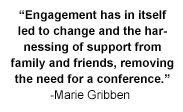 Gribben said that Diamond House was exploring the use of FGC with domestic violence, which has been an issue in a number of child welfare cases. She said they were influenced in this area by the work of Joan Pennell and Gale Burford, co-directors of the FGDM Project in Newfoundland, Labrador and New Brunswick, Canada in the 1990s. This project used an adaptation of New Zealand FGC to reduce domestic violence and by Hampshire County, England’s DOVE domestic violence project, directed by Sharon Inglis. (The DOVE Project will be covered in an upcoming IIRP eForum article focusing exclusively on FGC in Hampshire County.) Gribben also said that Diamond House was examining the use of FGCs with teen mothers, harnessing family support to help them care for their children.
Gribben said that Diamond House was exploring the use of FGC with domestic violence, which has been an issue in a number of child welfare cases. She said they were influenced in this area by the work of Joan Pennell and Gale Burford, co-directors of the FGDM Project in Newfoundland, Labrador and New Brunswick, Canada in the 1990s. This project used an adaptation of New Zealand FGC to reduce domestic violence and by Hampshire County, England’s DOVE domestic violence project, directed by Sharon Inglis. (The DOVE Project will be covered in an upcoming IIRP eForum article focusing exclusively on FGC in Hampshire County.) Gribben also said that Diamond House was examining the use of FGCs with teen mothers, harnessing family support to help them care for their children.
The Diamond House school group conferencing project is coordinated by Cathy McCann, who is an education welfare officer, a school vice principal and a school conference facilitator. Conferencing involves young people taking responsibility for and restoring the harm caused by their actions, said McCann. She said that they were inspired to use the Real Justice model after learning about it at a conference in April, 2000, from IIRP president Ted Wachtel and Terry O’Connell, director of Real Justice Australia, an IIRP program.
First, said McCann, they raised awareness about the pilot in their area. To date, nine schools have put themselves forward to participate. Presentations about the program are delivered to the schools’ entire staffs. “Everyone has to understand the process for it to benefit the kids,” said McCann. Referrals to the program come from education welfare officers (school social workers), other school personnel, non-school social workers and youth diversion officers (police officers who work with youth). “We have a good partnership with all the agencies,” said McCann. Most referrals are for behavioral issues: volatile conduct, bullying, being disrespectful to teachers, verbal assault and truancy. From September 2000 through April 2003, the conferencing program had 69 inquiries, 55 paper referrals, 27 conferences and 16 review conferences. Both Protestant and Catholic students are involved in the project, making it a cross-community endeavor, said McCann.
After a referral has been made, the young person is asked who he or she wants to attend the conference. Because the kids choose whom to invite, they take better ownership of the process, said McCann. Most choose their mother or father and sometimes extended family members and friends. Although McCann makes it clear that it’s preferable for both parents to attend the conference, usually only one parent does, often because the other has to work. Kids are asked if they want their friends to attend, but most choose not to invite them. Friends attending can be a positive element, though, said McCann, adding, “When a peer says, ‘Would you wise up?’ it’s better than adults saying it.” Depending on the case, others may attend, as well, including teachers, school administrators, social workers and youth diversion officers. “We want to deal with things holistically,” said McCann, adding, “It’s important that everyone understands what’s going on.”
McCann does pre-conference preparation, visiting students so that they understand the process and feel comfortable enough to participate and not “just say what they think we want to hear. The child needs to build trust in me,” she said. Conferences are held at school during the school day. The first year, they were held after school, but that wasn’t convenient for the teachers, said McCann.
In the conference, people are invited to sit in a circle, with the offender and the victim on either side of McCann and their supporters beside them, and are asked restorative questions: who was affected and how, how they feel about it, how to repair the harm. In that way, the students get to understand that their actions have an effect on people other than themselves, said McCann. There are no freeloaders at the meeting, she said, adding, “If a child can bear his soul, everyone else can too.” Toward the end of the conference, everyone comes up with a plan for how to prevent wrongdoing in the future and the child has to approve it. Future support for the child from professionals and parents is ensured at the conference. “If a kid is not getting support at home in some way, they’re not going to improve,” she said.
McCann told a story of a 16-year-old boy who had verbally threatened a teacher, been suspended from school several times and was about to be expelled unless he agreed to attend a conference. He had been an offered one once before and had declined. He asked McCann if he really had to have a conference. The process is voluntary, so she told him: You have a choice, but it’s limited—you can either have a conference or be expelled. He chose the conference because he wanted to take his exams.
 McCann discovered that the boy found it difficult to talk and that he was afraid he wouldn’t be able to get the right words out in the conference. She told him to write down the questions and answers so he wouldn’t forget them. He was prepared to say that he was sorry, that he felt guilty, that he never would have really hurt his teacher. At the meeting, the boy never needed to refer to his paper with the questions. He was articulate and made eye contact. He was back in school in two days. Two months later, he’s still doing fine. Afterwards, the boy’s school principal said that he couldn’t believe he was the same person. Said McCann: “He needed to hear: ‘You can do it,’ rather than ‘We don’t want you here.’” Another 12-year-old had also been suspended several times. In the conference he heard his father say—for the first time—that he was proud of him. At the end of the conference when the boy was asked what had surprised him about the meeting, he said, “That my daddy could be proud of me.” This is very powerful stuff, said McCann.
McCann discovered that the boy found it difficult to talk and that he was afraid he wouldn’t be able to get the right words out in the conference. She told him to write down the questions and answers so he wouldn’t forget them. He was prepared to say that he was sorry, that he felt guilty, that he never would have really hurt his teacher. At the meeting, the boy never needed to refer to his paper with the questions. He was articulate and made eye contact. He was back in school in two days. Two months later, he’s still doing fine. Afterwards, the boy’s school principal said that he couldn’t believe he was the same person. Said McCann: “He needed to hear: ‘You can do it,’ rather than ‘We don’t want you here.’” Another 12-year-old had also been suspended several times. In the conference he heard his father say—for the first time—that he was proud of him. At the end of the conference when the boy was asked what had surprised him about the meeting, he said, “That my daddy could be proud of me.” This is very powerful stuff, said McCann.
The stumbling block to people accepting the idea of conferencing in schools has been the fact that it’s a real change from what they’re used to, said McCann. Now, she said, kids are being maintained within the school system because of the support systems developed in conferences, instead of being expelled. Said McCann: “When you give young people a chance to speak that’s enough to empower them to take responsibility for their actions.” The whole process has to be acknowledged, McCann said, adding, “If I meet with them several times, sometimes they don’t need the conference.” Barnardos is hoping to engage with 70 families and do 25 FGCs and 25 school conferences in Northern Ireland in the coming year.
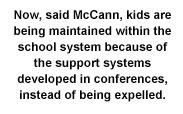 In the Republic of Ireland, the FGC and restorative justice conferencing models are being combined in restorative justice initiatives for young offenders. The information below was obtained from a conversation with Kieran O’Dwyer, Head of Research for An Garda S'ochan√جø¬Ω (Ireland’s National Police Service), at the Garda Research Unit, Garda S'ochan√جø¬Ω College, Templemore, County Tipperary, Republic of Ireland. This article also cites a paper addressing an overview of results from evaluations of 83 cases, which O’Dwyer presented at the Second Conference of the European Forum for Victim-Offender Mediation and Restorative Justice, in Oostende, Belgium, October 2002.
In the Republic of Ireland, the FGC and restorative justice conferencing models are being combined in restorative justice initiatives for young offenders. The information below was obtained from a conversation with Kieran O’Dwyer, Head of Research for An Garda S'ochan√جø¬Ω (Ireland’s National Police Service), at the Garda Research Unit, Garda S'ochan√جø¬Ω College, Templemore, County Tipperary, Republic of Ireland. This article also cites a paper addressing an overview of results from evaluations of 83 cases, which O’Dwyer presented at the Second Conference of the European Forum for Victim-Offender Mediation and Restorative Justice, in Oostende, Belgium, October 2002.
A juvenile diversion program has been in operation in Ireland since 1963 without statutory backing, said O’Dwyer. The Children Act 2001 has since provided support for restorative justice interventions, including a police referral provision, which was brought into effect in May 2002. Under the Act, all young offenders who admit responsibility for their criminal behavior must be considered for diversion “unless the interests of society require otherwise.”
Ireland’s youth justice diversion program was inspired by New Zealand youth justice FGCs, but unlike New Zealand’s program, it is entirely voluntary. O’Dwyer considers the voluntary aspect, for both offender and victim, to be critical, as “it helps ensure that the event itself and any agreement it produces are not seen as punishment.” It also helps ensure “positive engagement with the process and commitment to any agreement.” The program operates differently from the New Zealand model in other ways, said O’Dwyer. It is closer to the Thames Valley (UK) restorative conferencing program, he said, but unlike that program, is used only with young people, not adults. (For a research summary about the Thames Valley Police Initiative in Restorative Conferencing, go to: https://www.iirp.edu/images/pdf/thamesvalley.pdf.)
The restorative interventions used in diversion are commonly referred to as either restorative cautions or family conferences. To avoid confusion, said O’Dwyer, the term “restorative police event” is often used. (A police caution is the formal disposal of a criminal case without the involvement of prosecutors or the courts.) A restorative caution includes discussion of the offender’s criminal behavior. After the formal caution “finger-wagging” is done, said O’Dwyer, a conference is a chance to bring people together to focus on a specific occurrence, with an emphasis on drawing up an action plan. In this context, said O’Dwyer, FGC is “not terribly different from restorative conferencing.”
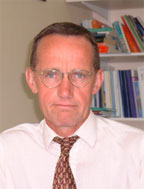 |
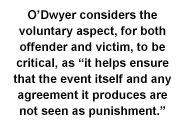 |
In the family conference, the young person is made accountable for his actions, the victim can attend and tell his story, the young person can apologize for the harm he has done and possibly arrange to make reparations, including financial compensation, and an action plan is prepared to prevent a recurrence of offending behavior. Conferences are recommended and facilitated by juvenile liaison officers (JLOs), Gardai (police officers) specially trained to work with young people. JLOs are “the gatekeepers to the Garda system of restorative justice,” said O’Dwyer. They are “not like the real police,” he said, adding, “They’re almost never in uniform and can go into places where others can’t go.” All JLOs are trained in restorative justice. A different JLO facilitates the conference from the one who is supervising the case, to provide distance and protect against the danger that the JLO would try to implement his or her own agenda at the conference.
As in FGC, the conference begins with preparation. “Preparation is everything,” said O’Dwyer. The facilitating JLO visits the family of the youth offender and that of the victim. This is something that needs to be looked at carefully, said O’Dwyer, adding, “We don’t want JLOs making deals” between victims and offenders before the conference about reparation amounts or directing the process too much in other ways, e.g., recommending anger management for offenders. ‘This is not the way it should work,” said O’Dwyer.
Conferences are held in community centers, hotels, sometimes at schools if they’re involved—somewhere everyone feels safe. Conferences used to be held in police stations, said O’Dwyer, but they’re moving away from that now. Conferences are often held in the evening. One advantage to having police as facilitators is that they’re on duty at night, said O’Dwyer. If the victim is young, it’s possible that he or she might not attend the conference, only his or her parents. If either the victim or the offender is under 18 years of age, parents are required by law to be involved. Participation of a large extended family is rare. Usually only a few people from the family attend, said O’Dwyer.
Ground rules are agreed upon at the beginning of the conference, including a requirement to listen to each other respectfully, an assurance that everyone will have a chance to speak and that the proceedings will be confidential. The Real Justice script is used. A conference begins with the facilitator asking the offender: What happened? What were you thinking about at the time? What have you thought about since the incident? Who do you think has been affected by your actions? How have they been affected? Who was affected? The victim is asked: What was your reaction at the time of the incident? How do you feel about what happened? What has been the hardest thing for you? How did your family and friends react when they heard about the incident? The victim’s parents and supporters, and the offender’s parents and supporters are asked similar questions and the offender is asked if he or she has anything else to add. Private family time, as used in the New Zealand model, when the family is left alone to make its own decisions regarding an action plan, is offered, said O’Dwyer, but most people don’t take it.
The key elements of the conference, said O’Dwyer, are an apology from the offender to the victim and a promise not to repeat the offense. The offender must show true remorse, he said. Most action plans tend not be too complicated or ambitious. Reparations, including “onerous duties and obligations” are not usually a feature of action plans, but often service to the victim is included. Plans may involve joining a club, taking part in a special police project, staying in school, going for counseling or paying reparations to the victim. There are rarely over two elements in any plan, said O’Dwyer.
Some very serious offenses have been dealt with successfully in a restorative way, said O’Dwyer. At first, JLOs tried to stay away from conferencing the harder cases but now they are deliberately choosing those cases to conference—such as those involving grievous assault—and some of those conferences are really dramatic and emotional. “At the beginning of the first conference I was a skeptic,” said O’Dwyer, but now he sees conferences as “the most natural way to deal with the harm caused.” In conferences, people see that others have their best interests at heart, he said.
“The restorative justice philosophy fits well with the Garda commitment to giving young offenders a second chance under the Juvenile Diversion Program,” said O’Dwyer. He feels that a significant start was made when restorative justice was introduced on a pilot basis before the enactment of the Children Act, and hopes that the Act will present opportunities to mainstream the restorative approach. O’Dwyer would like to see the process tried to its full potential and envisions much wider implications, including implementation with adults as well as young people.
Olmsted County, Minnesota, USA has been the in the forefront of Family Group Decision Making (FGDM) initiatives. FGDM is part of Minnesota’s Alternative Response program. The Alternative Response program is a strength-based and community-oriented approach to addressing child maltreatment reports that do not meet statutory requirements for a mandated investigative approach, which ensures that children are safe, avoids negative labels for parents, sets aside the issue of fault, works in partnership with parents, identifies families’ needs, provides services and resources matched to those needs and builds on parents’ and communities’ strengths and resources.
 The Olmsted County FGDM project began in 1996. Suzanne Lohrbach is supervisor of Child Protection Services (CPS), Olmsted County Community Services. Lohrbach said that in designing its FGDM program, Olmsted CPS was influenced by the UK Department of Health publication: “Child Protection and Child Abuse: Messages from Research, 1995,” which advocated partnerships between social workers and families as well as collaboration among professionals, as opposed to the traditional, paternalistic approach where professionals talk only to each other and exclude families. Lohrbach said that they look at FGDM as a partnership and at “how to connect that with a family centered practice.”
The Olmsted County FGDM project began in 1996. Suzanne Lohrbach is supervisor of Child Protection Services (CPS), Olmsted County Community Services. Lohrbach said that in designing its FGDM program, Olmsted CPS was influenced by the UK Department of Health publication: “Child Protection and Child Abuse: Messages from Research, 1995,” which advocated partnerships between social workers and families as well as collaboration among professionals, as opposed to the traditional, paternalistic approach where professionals talk only to each other and exclude families. Lohrbach said that they look at FGDM as a partnership and at “how to connect that with a family centered practice.”
Minnesota has 300-plus facilitators trained in FGDM, which is the preferred process in child welfare cases in Olmsted County, said Lohrbach. “Families are told: ‘This is what we do,’ ” she said. If a family objects to the process, a more traditional approach is taken, but it’s much more piecemeal and takes longer. Olmsted CPS has performed satisfaction surveys in which an overwhelming majority of respondents, both families and service providers, found FGDM to be useful and helpful.
FGDM is used in many situations in Olmsted: in early intervention cases, in alternative response safety plans, with juvenile sex offenders, in transition from treatment to foster care, in adolescent independence plans and in TANIFF (Temporary Assistance to Needy Families) cases to decide plans for families when public assistance runs out. Lohrbach’s ultimate vision is of “open community referrals” whereby anyone—related to child welfare or not—may develop an FGDM plan for the care of an elderly relative, a terminally ill parent, a child or others.
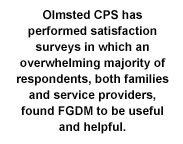 Several different FGDM models are used in Olmsted County, including the New Zealand FGC model, which incorporates private family time, and the Family Unity Meeting (FUM) model, which does not include private family time but stresses devoting time to exploring the family’s strengths and concerns. The decision about which model to use is fleshed out during conference preparation, sometimes based on whether there are enough family members to use private family time, said Lohrbach.
Several different FGDM models are used in Olmsted County, including the New Zealand FGC model, which incorporates private family time, and the Family Unity Meeting (FUM) model, which does not include private family time but stresses devoting time to exploring the family’s strengths and concerns. The decision about which model to use is fleshed out during conference preparation, sometimes based on whether there are enough family members to use private family time, said Lohrbach.
As FUM was the first model introduced in Olmsted, facilitators are accustomed to incorporating strengths and concerns in their meetings, said Lohrbach, but she wondered about the process’s “cultural relevance.” She asked: “Who is it for—the family or the facilitator? Is it designed just to keep a comfortable, positive atmosphere?” She thought that the strengths and concerns segment might cause meetings to lose focus. On the other hand, Lohrbach had concerns about the presentation of facts portion—or information-giving time—in the New Zealand FGC model, asking: “What is that? It could be interpretation, values, what social workers bring with them to the meeting.”
The primary model in use in Minnesota is an FGC hybrid, which both explores strengths and concerns and employs private family time. Lohrbach said that they were trying to return to a “purer” FGC model, one closer to the original model developed in New Zealand. She commented: “It’s okay to do different things but you have to be careful not to blur the models.” Looking at a pure model is important for research purposes, to ensure that the data is meaningful. “The accountability model, the circle process, all these are fine,” she said, but in order to institute good process and practice, you have to know what it is, to be able demonstrate its effectiveness. “If you can’t do that,” she said, “it dies.” Finally, said Lohrbach, “All these new models worry me. I’m not sure we have to keep reinventing the wheel. I hope we never see a Minnesota model of FGDM. We want to have international relevance.”
Lohrbach said she thought it was critical that FGDM be mainstream practice. But, she said, “It can’t be used for everything.” Preparation is essential to determine if there is a decision to be made, and if the social worker or the probation officer is willing to share power with the family. FGDM won’t work if they are not. Because it’s our usual practice at Olmsted CPS, she said, these objections are rare in child welfare.
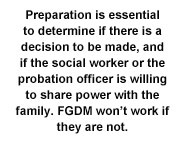 Progress has been slower in juvenile probation, said Lohrbach, adding, “there is no real conferencing being done around youth justice.” Real Justice practice has been murky and blurred, she said, and there are several different [restorative justice] models used in Minnesota in the context of youth justice—from victim offender mediation to circles and restorative conferences. There had been similar confusion in the child welfare area. In 1997, the Minnesota legislature inserted language into the child welfare law about relative (kinship) care agreements and conferences calling for training in mediation skills. Lohrbach said that she and her colleagues succeeded in changing the language to specify FGDM instead. Lohrbach said that she would like to bring youth justice into her unit. “The intent of Ted [Wachtel, of the IIRP] and Lisa [Merkel-Holguin, of American Humane] is to bring the youth justice and child welfare groups together, to untangle the blur that’s happened here,” she said.
Progress has been slower in juvenile probation, said Lohrbach, adding, “there is no real conferencing being done around youth justice.” Real Justice practice has been murky and blurred, she said, and there are several different [restorative justice] models used in Minnesota in the context of youth justice—from victim offender mediation to circles and restorative conferences. There had been similar confusion in the child welfare area. In 1997, the Minnesota legislature inserted language into the child welfare law about relative (kinship) care agreements and conferences calling for training in mediation skills. Lohrbach said that she and her colleagues succeeded in changing the language to specify FGDM instead. Lohrbach said that she would like to bring youth justice into her unit. “The intent of Ted [Wachtel, of the IIRP] and Lisa [Merkel-Holguin, of American Humane] is to bring the youth justice and child welfare groups together, to untangle the blur that’s happened here,” she said.
A parallel justice process is in use in family court, said Lohrbach. Families are now ordered to what is called a Family Case Planning Conference when it has been determined through screening that there is a legal interest in child protection. Cases are brought to a Family Case Planning Conference prior to filing a petition for custody or supervision. The process is completely family-involved, non-exclusionary and non-adversarial: public defenders, lawyers, social service providers and families attend. A guardian ad litem may represent a child. The purpose is to develop the next step for the child. Better than half of these meetings have referred to an FGDM to flesh out a plan, said Lohrbach.
The Etobicoke Family Group Conferencing Project, in Toronto, Ontario, Canada, serves the Toronto metropolitan area. Jeanette Schmid is Coordinator of the program, based at the George Hull Centre for Children and Families. Their website is www.georgehullcentre.on.ca. Schmid joined the FGC project in 1998. The program initially focused exclusively on cases referred from child welfare, but since 2002 it has also incorporated children’s mental health cases. Every FGC, whether for child welfare or child’s mental health concerns, now has two supervisors from two agencies: one from Children’s Aid and one from Children’s Mental Health. The George Hull Centre for Children and Families, the Etobicoke Children’s Centre, the Children’s Aid Society of Toronto (Etobicoke) and the Catholic Children’s Aid Society of Toronto (Etobicoke) collaborated on the FGC project, which was funded by the Children’s Aid Foundation.
To read a report, “Program Design: The Family Group Conferencing Project Etobicoke” go to: www.iirp.edu/article_detail.php?article_id=NDkz.
The project has held 70 FGCs, some repeat, since April 1998. A majority of the children in these conferences returned to kinship care, although not necessarily to the care of their parents. The result was “higher than expected, and borne out by other results obtained internationally” said Schmid. The results were also better than those in cases where FGC was not used, she said. However, said Schmid, it’s important not to define success in FGC as family preservation. More significant is that “the secrecy is ended around certain issues,” and that the extended family is given an opportunity to play a role in ensuring a child’s safety.
Feedback about the program indicates that families appreciate having a voice and that FGC makes families feel closer and more comfortable asking each other for help. Also, said Schmid, FGCs change the way professionals perceive and are perceived by families. Through FGCs, professionals learn that there really are strengths in families and families feel that professionals better understand their issues.
“It takes hard work to increase the pool of referring social workers,” said Schmid, but those who do refer to FGCs find that the process is a respectful way of dealing with people and tend to refer to FGCs again. Agency workers’ heavy case and paperwork loads have affected FGC referrals because of the inaccurate perception that FGCs take more time than conventional processes, said Schmid. Also, deaths that have occurred under Children’s Aid supervision (unrelated to FGC), have made workers afraid refer to FGCs because of the perception—again inaccurate—that sharing power is a risk.
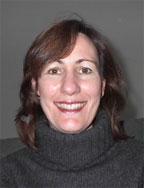 |
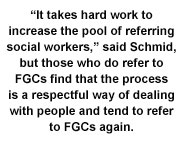 |
The Etobicoke project uses the New Zealand FGC model with minor adaptations, said Schmid. Preparation is critical. With over 150 different ethnic, cultural and language groups, Toronto is the most culturally diverse city in the world, said Schmid. The conference is held in a neutral venue and begins by welcoming everyone with any ritual the family chooses—prayers, songs, Bible readings, animistic libations or tributes to the deceased. After a go-round of introductions, the family shares their hopes for the day and sets guidelines and safety plans for the meeting. Next, professionals present brief reports about the child’s situation and address “bottom line” issues, such as the family’s history of substance abuse and permanence time limits set by the province: one year in government or foster care is permitted for a child under age six, two years for a child over six. There follows a concise discussion of the family’s strengths and concerns. “We don’t brainstorm strengths and concerns like in the California model,” said Schmid. Sometimes, as in the New Zealand model, neutral experts on particular topics, such as grief counselors, are invited to share expertise and answer questions. Halfway through the conference is often the time for a meal break.
The second part, private family time, when the family comes up with a plan for the child, is “sacrosanct,” said Schmid. ‘The only direction I give,” she said, “is to write on their flip chart: Who, What, When, Where, How.” The professionals, including researchers, stay outside the room during private family time. “If family members come out and tell us things aren’t going well, we will work with them and get them to go back inside,” said Schmid.
When the family is ready, it presents the plan to the professionals, who then ask questions. In the past, families felt they were losing control of the process during this part of the meeting, said Schmid, adding, “Workers were doing too much to flesh out the plan.” Now, she said, if necessary, the professionals ask for more detail on the plans, sending the family back into private time. Then the issue of “next steps” is addressed. One third of families ask for a follow-up conference. In a final go-round, all participants say whether or not the process has been useful to them. Schmid delivers a copy of the plan to everyone—families and professionals—within 10 days.
It’s up to children whether or not they attend the conference. For the most part, children of all ages do attend. “With the child present, people stay on the subject at hand—the child,” said Schmid. For children, the conference breaks the secrecy about what’s been happening to them. Although it can be distressing for children to hear about abuse and family problems, it’s also reassuring to hear people talking about plans for their safety and to know that people care about them. Children age four and up are asked what they want the adults to know. The child’s support person, a non-professional chosen by the child to aid him or her throughout the FGC process, can help elicit this information. The conference can be the first time some extended family members meet the child and this in itself can be a very emotional experience. On balance, said Schmid, it’s better for the child to be there.
 There has been no move as yet to incorporate FGC into law in Ontario. Schmid hopes that FGC will soon be officially recognized and financially supported. At the Catholic Children’s Aid Society, an important partner in FGC practice, social workers are now asked as a matter of course whether they’ve thought about using FGC in each case, and if not, why not. Schmid would like to see this as general practice in all child agencies. She believes, however, that FGCs should always be voluntary: “Neither families nor professionals should be coerced.” Still, she thinks that the decision about whether to hold an FGC should not be left only to the parents, but to the family network as a whole.
There has been no move as yet to incorporate FGC into law in Ontario. Schmid hopes that FGC will soon be officially recognized and financially supported. At the Catholic Children’s Aid Society, an important partner in FGC practice, social workers are now asked as a matter of course whether they’ve thought about using FGC in each case, and if not, why not. Schmid would like to see this as general practice in all child agencies. She believes, however, that FGCs should always be voluntary: “Neither families nor professionals should be coerced.” Still, she thinks that the decision about whether to hold an FGC should not be left only to the parents, but to the family network as a whole.
North Carolina, USA has been a center for FGC work. Joan Pennell is professor and director at North Carolina State University Social Work Program and principal investigator of the North Carolina Family-Centered Meetings Project. She and Gale Burford were co-directors of the FGDM Project in Newfoundland, Labrador and New Brunswick, Canada, in the 1990s, which used an adaptation of New Zealand FGC to reduce domestic violence.
In fall, 1998 Pennell began a four-year child welfare project, training families and introducing FGC to North Carolina. Her article about mainstreaming FGC can be read at: http://www.iirp.edu/article_detail.php?article_id=NDky.
“We began by involving communities,” said Pennell. The project kick-off included social services professionals, police, foster parents and others. Community liaisons were chosen to help plan the training and tailor it to each area. Local advisory groups were set up to involve interested people, such as domestic violence counselors and pastors, who were really important, especially in the beginning, said Pennell. Coordinators varied by community, she said, but they were never the same people as those carrying the cases. A statewide advisory committee was formed, including state and county representatives from the Department of Social Services, police, the courts and domestic violence and disabilities agencies, which “gave richness to the discussion,” said Pennell.
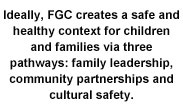 From the start, there was general enthusiasm for the FGC model, although concerns were voiced: Are families articulate enough to express themselves? Will they come? How will social service workers deal with coordinator training? Over time, project managers learned that additional training was needed for social workers, regarding which families to refer to FGCs, how to present family history in a way that families can use it constructively, what to do when children come to conferences or how to handle a conference out of state. The group situations of FGCs can be intimidating for social workers, who are mostly accustomed to one-on-one interactions, said Pennell. Extra by-request training is still on-going. Project evaluation also found a need to monitor plans devised at FGCs or to convene follow-up conferences.
From the start, there was general enthusiasm for the FGC model, although concerns were voiced: Are families articulate enough to express themselves? Will they come? How will social service workers deal with coordinator training? Over time, project managers learned that additional training was needed for social workers, regarding which families to refer to FGCs, how to present family history in a way that families can use it constructively, what to do when children come to conferences or how to handle a conference out of state. The group situations of FGCs can be intimidating for social workers, who are mostly accustomed to one-on-one interactions, said Pennell. Extra by-request training is still on-going. Project evaluation also found a need to monitor plans devised at FGCs or to convene follow-up conferences.
FGCs are in use in North Carolina in two types of child welfare cases: those on the “assessment track,” involving need, neglect or dependency—(80 percent of cases), and those on the “forensic track,” involving abuse and the legal system—the “deep end” cases. Ironically, said Pennell, while professionals are often afraid to make referrals to FGCs from the forensic track, they end up doing it anyway because they don’t know what else to do.
Ideally, FGC creates a safe and healthy context for children and families via three pathways: family leadership, community partnerships and cultural safety. The FGC model should include an independent coordinator, thorough preparation, clear information for families, family private time, a clear process for final plans and a way to integrate plans into “work as usual,” AKA mainstream practice. The last is frequently the toughest piece, said Pennell. Too often, the FGC-devised plan “sits in the file next to the social services plan and the two are never put together,” she said. This problem speaks to a need for sustaining partnerships that make the process work: with the courts, community services and cultural groups. “The family leads the process,” said Pennell, “but it should not be dumped on its own to do it alone.”
 |
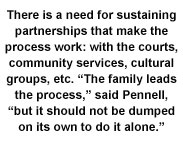 |
Another issue important to Pennell is “cultural safety,” a New Zealand term meaning that a context must be created in which it is safe for the family to express its own social values. Social service workers must be able to relate to different cultures. In North Carolina, for example, meetings often open with prayer or gospel songs.
FGC practice guidance developed for North Carolina based on the New Zealand model has been accepted by the state. North Carolina is now undertaking child welfare reform, looking at an alternative response system similar to that in Minnesota, said Pennell. She is also planning to use FGC in domestic violence cases, via the Safety Conference model, which is in the planning stages.
In California, USA, family group conferencing is widespread. Paul Sivak is a professor of social work at California State University, Stanislaus County, California and coordinator of the Child Welfare Training project. He provides training and support to agencies developing family group conferencing. He is also on advisory committees to the National Center on FGDM of the American Humane Association.
Out of 58 counties in California, 30 are “playing with family conferencing, with different levels of commitment,” said Sivak. In training, Sivak said that he emphasizes “the fundamental values that underpin the various models of family conferencing,” including the two “sacred” elements of “intense pre-meeting work” and private family time, both of which “must be adhered to absolutely.” Any other structure is good, he said, so he trains people in “what works best for them.” Models he uses include everything from FGC, which, he said, employs a “facilitated meeting with a short period of information-sharing,” all the way to a longer facilitated meeting, stressing strengths and concerns.
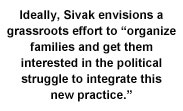 Sivak is leaning toward the FGC model. “Social services people are reasserting themselves” via strengths and concerns, said Sivak, adding, “Many families who have gone through the family conferencing process didn’t have a real family conferencing experience.” All models can be “just as dangerous, unless we shift the value base and build in self-reflection devices,” he said. In Stanislaus County, a pool of 15 – 20 facilitators meets once a month to process their experiences with family conferencing and share successes and failures “with an eye toward going back to the value base,” namely, that the family directs development of the plan for the child and that a partnership grows between social workers and families. Solano County, California is setting up a group, which will include county child welfare workers and community NGOs, to address family conferencing. The 25 “committed folks of the California practitioners’ round-table” meet every three months in various locations around the state to talk out issues related to family group conferencing.
Sivak is leaning toward the FGC model. “Social services people are reasserting themselves” via strengths and concerns, said Sivak, adding, “Many families who have gone through the family conferencing process didn’t have a real family conferencing experience.” All models can be “just as dangerous, unless we shift the value base and build in self-reflection devices,” he said. In Stanislaus County, a pool of 15 – 20 facilitators meets once a month to process their experiences with family conferencing and share successes and failures “with an eye toward going back to the value base,” namely, that the family directs development of the plan for the child and that a partnership grows between social workers and families. Solano County, California is setting up a group, which will include county child welfare workers and community NGOs, to address family conferencing. The 25 “committed folks of the California practitioners’ round-table” meet every three months in various locations around the state to talk out issues related to family group conferencing.
Sivak would like to see the families themselves included in these groups. Groups of families have been meeting on their own to share their experiences with family group conferences and with Child Protective Services. There have also been similar meetings that include both families and social service providers. During the first joint meetings, the professionals were “incredibly defensive” because they’d never perceived themselves as equals of families, said Sivak. “The family-only meetings were very loud and full of laughter,” he said. The last two joint family and professional meetings were also full of laughter but it took community building to get to that point, said Sivak. Family group conferencing must be seen as a long-term community builder, he said.
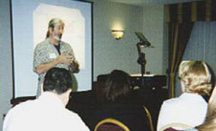 |
 |
Ideally, Sivak envisions a grassroots effort to “organize families and get them interested in the political struggle to integrate this new practice.” To that end, he is implementing a long-term “participatory research” project with families. “Our research is based on tools generated by families,” he said, adding, “Families tell us what we should measure and what questions to ask.” Through facilitated focus groups, Sivak has found that families are interested in the change of the nature of relationships inside the family and “the quality of well-being.” Research questions that families would ask include “does the family network really feel that they share responsibility for the child?” and “would you rather handle problems as a group or as an individual?”
Family members, not social workers or professional researchers, are now conducting the research interviews, although not necessarily within their own families. The process may be more time consuming, said Sivak but the end result is “data that’s more rich and more reliable.” Families, “totally uncoaxed” realize that research can be a tool for social change, not just a measurement, and that documentation is power. The non-dominance-based partnership of family conferencing evokes a power that touches a natural part of us, he said. “Restorative practices and family conferencing have the same goal,” said Sivak: rebuilding community and returning healing and decision-making power to people.
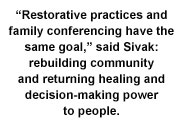 Sivak believes that family conferencing must always be voluntary. The California practitioners group is lobbying to short-circuit a move by the state that would require family group conferencing. He would rather see government departments obliged to educate providers about the practice so that they would be prepared, rather than required, to provide it. Said Sivak, “The argument that the ends justify the means is always wrong.”
Sivak believes that family conferencing must always be voluntary. The California practitioners group is lobbying to short-circuit a move by the state that would require family group conferencing. He would rather see government departments obliged to educate providers about the practice so that they would be prepared, rather than required, to provide it. Said Sivak, “The argument that the ends justify the means is always wrong.”
Vermont, USA has long been the location of many FGC and restorative justice programs. Gale Burford is professor and Director of the State Child Welfare Training Partnership at the University of Vermont Department of Social Work. As previously mentioned, he and Joan Pennell were co-directors of the Family Group Decision Making Project in Newfoundland, Labrador and New Brunswick, Canada, in the 1990s.
Burford has several projects in proposal stage. He is planning an FGC demonstration project in 2003 to bring adult corrections and child welfare personnel together to examine how families overlap with one another in both agencies. But Burford is concerned that “new language” may be needed for the project because “the term family group conferencing sets off so many fusillades. People hear the word conferencing and they think it’s recklessly putting victims where perpetrators will be able to control them.” He thinks it might be safer to talk about “community-based empowerment.”
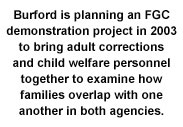 Burford is definitely an FGC enthusiast. “It contains everything I believe about how we get to lasting solutions,” he said, adding, “Everything tells us that the way to get the best results is to engage the person and members of their family and FGC is one of the only models around that satisfies the criteria.” But, he said, “It creates so much fear and opposition.”
Burford is definitely an FGC enthusiast. “It contains everything I believe about how we get to lasting solutions,” he said, adding, “Everything tells us that the way to get the best results is to engage the person and members of their family and FGC is one of the only models around that satisfies the criteria.” But, he said, “It creates so much fear and opposition.”
Asked the reasons for the fear and opposition, Burford said that his “harshest theory” posits a “deep, enduring mistrust of groups getting out of control, which can be traced right back to the McCarthy era. People doing this kind of thing were thought to be communists or socialists.” (Joseph McCarthy was a United States senator in the 1950s who spearheaded a relentless anti-Communist crusade.) Also, said Burford, FGC practices threaten professionals, positions and power and child welfare professionals are afraid they will be blamed if something goes wrong. “And they do get blamed,” said Burford. He cited the “gut-wrenching and sickening” case of Victoria Climbie, a little African girl who was tortured and killed in the UK In the aftermath, he said: “People were falling all over themselves with procedures, instead of working with people. A mountain of new procedures was developed, which simply created more ways for families to be excluded.”
There’s a pattern in the US, said Burford: Professionals give lip service to the notions of self-help and mutual aid, but then don’t refer to conferences. It’s the same thing in Sweden and the UK, he said. He cited a Swedish study that interviewed professional people, all of whom thought conferencing was a great idea but “within 18 months less than one-half or one-third had referred families” to the practice. Burford also discussed a Vermont FGC project of several years ago that he regards as an implementation failure. “Families loved it, coordinators loved it,” he said, but the government and NGO partnerships which had made it possible came undone. They dissolved the project despite the report confirming that families loved it. The problem, said Burford, is that there’s no legislation to back up such programs, so they can’t last. “Pockets of real enthusiasm are keeping them alive in different places, but once they diminish they start to lose steam.” In North America, he said, “where everything is so fickle with financing, if we don’t enshrine it in law, it’s gone.”
Burford reported on results of the on-line FGC survey he and Paul Nixon ran via the American Humane Association’s website. Over 200 responses were received, addressing how projects started, what obstacles people encountered and what had made the projects possible. “It was the same all over,” he said, “Practice is under threat of financial whims.” He contrasted this situation with that in New Zealand, where families have a right to the FGC process. On the other hand, wondered Burford, if government-sponsored programs dilute or corrupt practice, “are we better off skating along the margins?” He referred to an FGC training video produced by one the state governments in the US that showed a social worker inappropriately influencing the conference by sternly advising a family: “Your job is to decide which one of you takes this child home.” Added Burford, “Ted [Wachtel] has the right idea: develop strong national connections and build organizations to keep things going without politicians’ support. That’s hugely democratic.”
Asked how to help FGC programs endure, Burford said, “We have to move on a lot of fronts at once,” on the local and legislative levels and through education. As an example of success on the grassroots, local front, Burford cited the 1990s FGC domestic violence project in Newfoundland and Labrador: “We ran 10 conferences among 1600 people with 12 to 18 people in each. That’s not very many conferences before you have the entire community involved. That’s a revolution!”
As for legislation, Burford said that FGC practice and philosophy ought to be enshrined in law in “minimalist language,” e.g.: the family has the right be at all meetings where their situation is discussed; the state has the obligation to ensure support for families in getting to the meetings; there must be the opportunity to caucus without undue professional influence; support must be provided to carry out the family’s plan.
 |
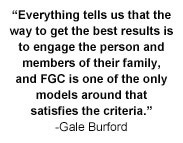 |
One of the biggest challenges to FGC is funding the plan, said Burford. But blocks to funding among various agencies and organizations usually “turn out to be things they’ve invented themselves.” Said Burford, “If we can go into an organization and get people together, we can figure it out.”
Concerning education, Burford said, “We have to get our feet into professional training programs and transform the brains of professionals. They’re the ones who are giving us the most trouble.” Social workers, psychologists and psychiatrists need to understand that FGC won’t harm vulnerable people, he said, and that FGC is the best way to honor people’s rights and consider the well-being of the community.
Burford concluded: “We must seize the ball soon while we have agreement on the left and the right or we will miss the opportunity.” In the US for the past decade, he said, an unlikely combination of people on the far-right and moderate-left has come to agree on certain principles. The right is saying to the left: “We are happy to hear that you no longer need to throw billions of dollars at welfare.” The left is saying to the right: “We’re glad you’re in favor of empowerment and community.” FGC appeals to a wide spectrum, said Burford, both “the family values crowd on the right and the empowerment people on the left.”
Author’s note: I want to thank the fascinating and dedicated people who kindly agreed to an interview with me during the past several months regarding family group conferencing. Everyone one I spoke with—from Finland to Australia—was excited about the power of the process and their enthusiasm was infectious. And although each person might not have agreed on all the finer points of language and methodology, all shared the underlying conviction that people and their families and friends are best equipped to make decisions about each other’s care and support. This belief is deeply democratic and it includes everyone: small children, the elderly, those who have been categorized as delinquent or mentally ill. I was profoundly moved by stories of how people’s lives were changed by the process. And I was encouraged to hear that practitioners and proponents of all the approaches are realizing that they are working toward the same goal: building a global alliance for family empowerment and restoring community in a disconnected world.
The Restorative Practices eForum will continue to feature FGC programs in the future. An article to be published soon will discuss FGC programs in child welfare, domestic violence, education and youth justice in Hampshire County, UK.

